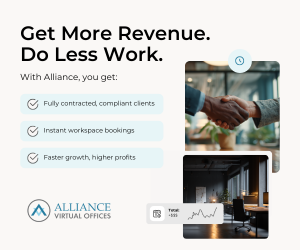- Every coworking space utilizes a unique mix of tools to streamline operations, drive growth, and enhance community experiences.
- Technology should complement, not replace, personal interactions between staff and members to foster stronger community connections.
- Align tech investments with business size, revenue turnover, and community needs to ensure the long-term sustainability of your coworking business.
Coworking spaces rarely rely on a single piece of technology to run business operations. Instead, it’s typical for coworking spaces to create a unique tech ecosystem, tailored to their specific needs, that balances tools for streamlining operations with those that drive growth and enhance the community experience.
But with so many tech solutions available (and not limited to coworking-specific software), building your ideal “tech stack” can, at times, feel overwhelming.
With guidance from coworking operators and managers, we’ve explored which tools your coworking space needs to thrive. Here’s our guide:
Get tools to support operational needs
While many tech solutions are available for coworking operators, a solid foundation typically involves adopting a platform that centralizes multiple tools.
As an example, Halkin, a U.K.-based flexible office space, uses coworking management software that “allows us to manage the space, including meeting room bookings, invoice clients, and integrates with various third parties like our accountancy software,” explains Director of IT, Benjamin Freedman. A platform that “offers secure, reliable, and scalable Wi-Fi and internet solutions” has also proven essential.
Integration tools can range from booking software to HR managers, and communication channels, but each coworking business has different motivations behind choosing their suite of digital tools.
For instance, Halkin’s adoption of access control solutions has overcome the “nightmare of managing keys when you have so many users,” says Freedman, who recommends using CCTV and security systems too.
Likewise, Suzanne Murdock, Co-founder and Managing Director of The Hub Newry, recommends access management systems to manage a membership base that brings in many visitors.
Former Marketing Director and Growth Director at Huckletree, Oliver Easton-Hughes (currently Chief Strategy Officer at Koho.ai), recommends access management solutions for bookable amenities, including meeting rooms.
In his opinion, building a tech ecosystem must be done with key consideration of how tools help you generate revenue.
He explained, “If a tool doesn’t provide you with a tangible ROI, there’s not any point in having it, because otherwise you’re adopting another piece of technology for the sake of it.”
Enhance community experience
Coworking isn’t just about operations, as workspaces exist to serve its community first and foremost.
It’s a “hospitality business at the end of the day,” explains Jonathan Bevan, CEO of Techspace, advising operators, “You’ve got to get the right mix of tech and people because you really mustn’t forget the people.”
This philosophy has influenced the approach to choosing technology solutions at Techspace. “I only want to provide tech in the company if it’s actually making the customer service or the customer journey better, not just tech for tech’s sake,” shares Bevan, who also expresses that it’s not replacing team members either. Whether working at the front desk or in the cafe, Techspace team members are encouraged to “interact with our members because that’s how we build a more personal connection.”
Interestingly, Techspace isn’t the only coworking business that approaches community interactions in a more personal way. The Hub Newry switched out an amenity booking tool because members didn’t take it up, replacing it with a whiteboard and pen for community members to organize meeting room bookings.
Likewise, Freedman mentions that Halkin also opts for more manual processes when advertising upcoming events by placing posters around the workspaces.
But when it comes down to member communication, the role of technology isn’t totally defunct. Former Community Manager at Townsq Islington, Anna Chuicharoen, recommends using a tech-enabled channel to communicate with members on the go, ideally where you can switch between mobile and desktop. Chuicharoen’s advice is — choose a chat tool that members already use.
Creating fantastic community experiences in coworking essentially helps reduce churn. Easton-Hughes recommends operators choose “a good member app, ticketing system, and a communication tool because these help you retain your clients for longer.”
Understand the power of marketing
Sales and marketing are essential to launching a new space and, regardless of your existing customer base, you’ll always be working on your sales pipeline to ensure the sustainability of your spaces.
Easton-Hughes suggests that, “Any tool that you bring into an organization that assists you in your marketing spend, gains intelligence to close a deal quicker, helps you retain a client for longer, or improves your NPS score” is important. That goes for “a decent sales and marketing system,” for making swift follow-ups, and qualifying prospects.
“Most operators that I’m speaking to, if they’re not already on a platform like that, they’re definitely looking to do so,” says Easton-Hughes, as “getting a lead, and responding to that lead quickly, is fairly crucial,” rendering that tech tool as essential. A powerful sales and marketing platform can even be used for effective remarketing campaigns via LinkedIn and Google ads.
While a CRM system is essential, Bevan recommends “providing a seamless customer journey, from getting that person on board through to them physically arriving and connecting them into your ecosystem.”
This also feeds into the topic of space utilization which, since the pandemic, “people are very focused on getting value for money, for what they’re paying in terms of space, and also very focused on how and when they use the space.”
Giving customers oversight of how they use your spaces showcases your commitment to customer relationships.
Don’t forget the tech stack investment
While all these tools and platforms sound highly beneficial, the process of choosing tech solutions comes down to two things — suitability for your coworking business, and of course, cost.
Coworking tech can be pricey, not only for the software implementation, but as tech suppliers can require regular costs to run, maintain, develop, and upgrade your coworking software. When choosing your coworking tech ecosystem, Suzanne advises operators to weigh up price “against revenue turnover…the services you’re offering and the size of your organization.” She also suggests that you get to know your community before choosing solutions that suit their needs.
“The margins in Flex are tight,” stresses Easton-Hughes, “so every opportunity you can find to generate revenue, or, more importantly, not lose revenue, that’s an area you should focus on. The tools you bring onto your business should help to support that.”


 Dr. Gleb Tsipursky – The Office Whisperer
Dr. Gleb Tsipursky – The Office Whisperer Nirit Cohen – WorkFutures
Nirit Cohen – WorkFutures Angela Howard – Culture Expert
Angela Howard – Culture Expert Drew Jones – Design & Innovation
Drew Jones – Design & Innovation Jonathan Price – CRE & Flex Expert
Jonathan Price – CRE & Flex Expert












